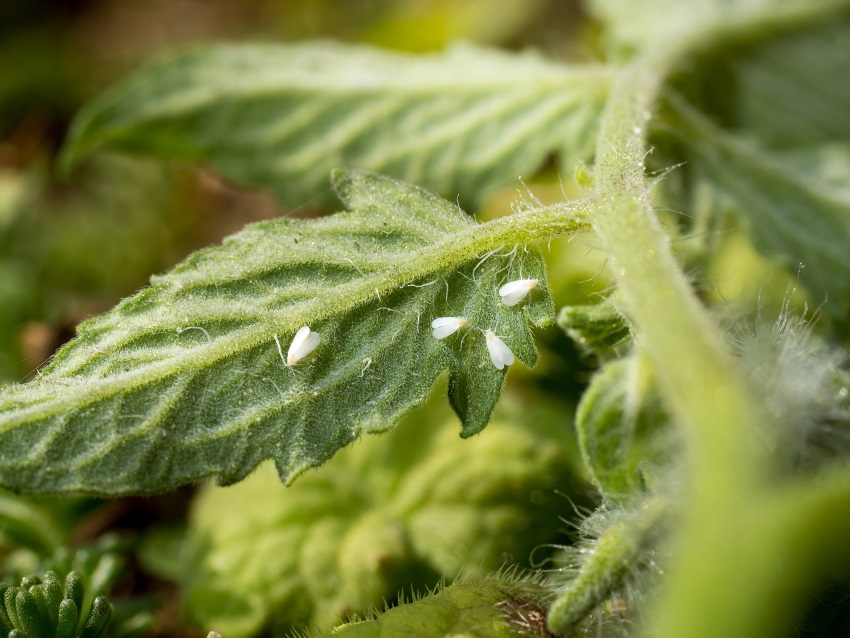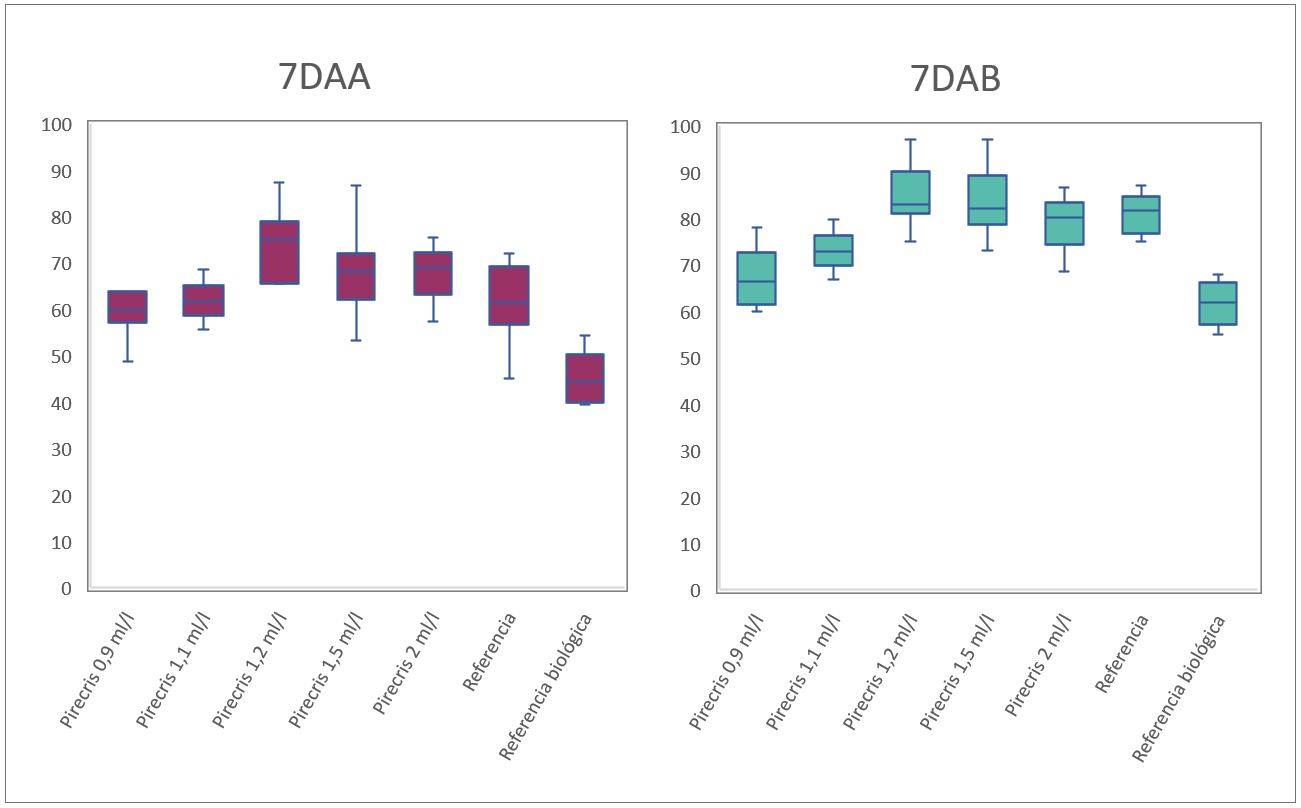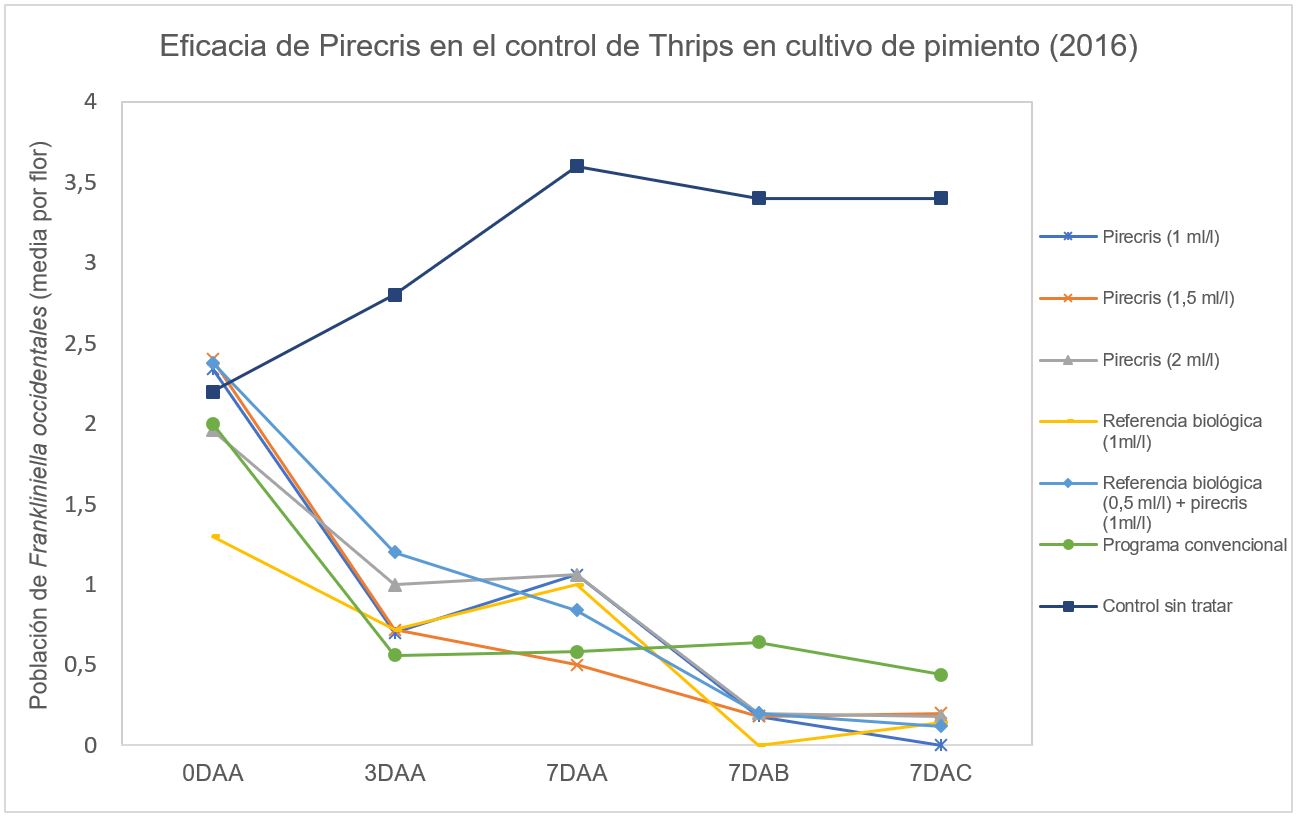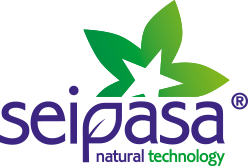Whitefly and thrip control in crops

Whiteflies on a tomato leaf
Whitefly and thrip control in crops became a pivotal matter to farmers at key moments in the campaign. The increasing presence of pests and diseases in the European territory and, on the other hand, the rejection the use of conventional sanitary defense methods is causing in consumers, result in the need to use biopesticides as a viable tool for the integrated management of plagues and diseases.
According to the Spanish Ministry of Agriculture, Spain produces roughly 20 million tons of fruit and vegetables. 2/3 of them are set aside for export and 1/3 are allocated for consumption. Shopping centers and consumers are increasingly strict when it comes to quality and lack of chemical residues. This is the reason why Spanish farmers have to be adapted to such new demands.
Such adaptation is not simple since the agricultural environment is constantly changing and evolving by itself. In addition to the demands of the current market, the pressure pests are putting on agriculture throughout Europe is increasingly important for several reasons.
On the one hand, not only the climate change but also the rise in global temperatures are causing the biological cycle of pests not to be broken. Pests are expanding to higher latitudes and this process is being developed more easily during all seasons of the year1. Moreover, vectors of viruses and bacteria are becoming increasingly effective in the spread of diseases due to their adaptation to new crops and environments2.
On the other hand, the emergence of insect resistances to specific synthetic molecules for control is increasingly common. This situation, coupled with the restrictions on the use of conventional synthesis tools, are forcing to search for other strategies for crop protection. In so doing, choosing the best biopesticide is essential to whitefly and thrips control in crops, especially when both the rises in temperature and the stage of plant development announces the possibility of pest incidence.
The analysis and the search of solutions to these problems have motivated the development of Pirecris, the new biopesticide with patented and registered formulation which was launched in the framework of Fruit Attraction 2017.
Pirecris' broad-spectrum insecticidal action ensures 100% efficacy. This fact makes it a sustainable, cost-effective and zero residues solution for crops. Likewise, Seipasa's biopesticide is positioned as a sophisticated solution to be included in Integrated Pest Management programs, providing high efficacy with zero residues.
Results for whitefly control
Whiteflies represent significant economic losses for farmers around the world who, year after year, suffer direct and indirect damages in crops. Bemisia tabaci (Gennadius) is a great problem for horticultural producers, since it transmits more than 150 diseases and has the ability to develop biotypes. These populations are more aggressive due to their reproductive capacity and the ability to colonize a greater number of host plants3.
Pirecris was designed to whitefly control due to its high efficacy to eliminate such pests. In addition, Pirecris has passed the most strict European controls and official tests that certify its excellent performance, efficacy, toxicology and zero residues.
Within the evaluation of Pirecris’ efficacy to whitefly control in crops, 16 GEP (Good Experimental Practices) trials were carried out in solanaceae (tomato and eggplant of typical varieties according to the location of each trial). Its design and evaluation were based on the guidelines published by EPPO (European and Mediterranean Plant Protection Organization).
Following the corresponding guidelines, homogeneous plots were found in order to make blocks of plants with repetitions and sufficient treatments for a representative statistical analysis (each trial had at least four repetitions and five treatments in each repetition). The product to be studied was always compared to plants without treatment and with plants treated with products already registered, with a similar mode of action.
Two applications per trial (A and B), with an interval of 7 days between them, were evaluated 3 and 7 days after each treatment (3DAA, 7DAA, 3DAB and 7DAB). The following results were obtained seven days after the first and second application (see figure 1).

Figure 1. Box & Whiskers diagram in which Pirecris performance (at different doses) is reflected in a statistical grouping of 16 efficacy trials seven days after the first (7DAA) and second application (7DAB) for Bemisia Tabaci control in solanaceae (tomato and eggplant). As a biological reference, 4% natural pyrethrins were used and, as a conventional reference, 20% imidacloprid chemical synthesis.
The doses studied for whitefly control in solanaceae ranged between 0.9 and 2 ml/l, making the 1.2 dose the most efficient, combining efficacy and profitability of the treatment, both seven days after the first (7DAA) and second application (7DAB) of Pirecris respectively.
In addition, a high and homogeneous pressure of B. tabacci was initially observed in the different blocks (incidences between 20-40%; severities of 7-15 individuals for leaf). In all cases, the average efficacy achieved by the product (70-80%) exceeds those of the biological reference (4% natural pyrethrins with maximum efficacy of 50-60%).
Compared to the conventional reference product (Imidacloprid 20% with an average efficacy of 60-70%), Pirecris achieves similar results without statistical difference and higher efficacy in most cases. Thus, the strong shock effect concerning the drop of populations is validated. Pirecris is able to reduce whitefly population more than a half in each application. Furthermore, Pirecris facilitates the release of auxiliary fauna without adding residues to the harvest.
Results for thrips control
Frankliniella occidentalis (Pergande) is a very polyphagous species, capable of colonizing and parasitizing most horticultural crops, describing more than 200 host plants4.
Such species of Thysanoptera, as occurs with B. tabacci, causes direct and indirect damage to crops. As direct damages, food stings and the effects of laying are classified 5. On the one hand, indirect damages are caused by the infection of phytopathogenic fungi and bacteria through wounds produced by food stings. On the other hand, indirect damages are also caused because of its action as a virus transmitting vector. F. occidentalis, which is the main and most effective vector of tomato tanning virus (TSWV)6.
Regarding thrips, in figure 2 (see figure 2) we can observe the results of a trial in which different management strategies of F. occidentalis in pepper were compared. Three product applications were made. They were evaluated at an initial moment (0DAA), 3 days after the first application and 7 days after the first, second and third application respectively (3DAA, 7DAA, 7DAB and 7DAC). The design of the trial was carried out following EPPO guidelines for thrips control. Six different treatments, but also an untreated absolute control, with four repetitions and distribution by random blocks, were the main features of this study.

Figure 2. Evolution of F. occidentalis populations (average of individuals per flower in different blocks) in pepper during the trial. As a biological reference, 4% natural pyrethrins were used and deltamethrin was used as a standard reference for chemical synthesis. The conventional program corresponds to the complete set of treatments carried out in the area as the most common strategy.
In this trial, both the shock effect and the population decline can be observed since the first application (3DAA). In the untreated control, the population rose almost twice in seven days, but treatments with Pirecris were able to reduce to practically zero the thrips average without any difference from a conventional program. Such knock-down effect is repeated after each application, obtaining successful results in all evaluations.
Whitefly and thrip control in crops: why choosing the best biopesticide is important
The increasing pressure of pests in horticultural crops remarks the need of new, sustainable and profitable tools for farmers. Not only are the direct damages caused by these pests in crops important, but risk as vectors in the transmission of phytopathogens must be also considered.
Pirecris is a new and effective solution suitable for resistance management strategies, zero residues strategies, organic farming and integrated pest management. Application and proper use of Pirecris facilitates the settlement of auxiliary fauna in crops.
Efficacy and population control in different trials in Solanaceae, both with whitefly (B. tabacci) in tomato and eggplant, and thrips (F. occidentalis) in pepper, show the excellent results obtained during the last years in the process of product registration, whose formulation is the only one patented in its category.


